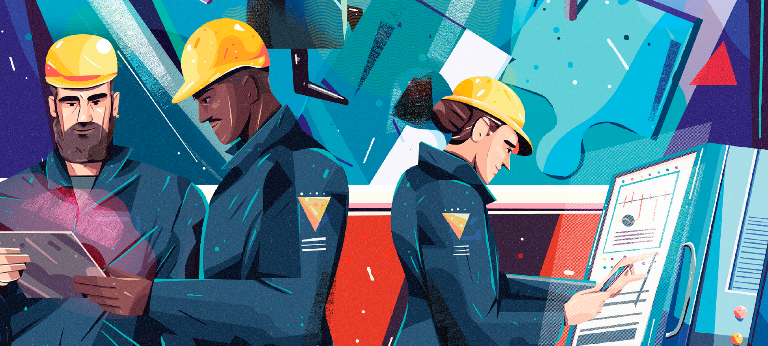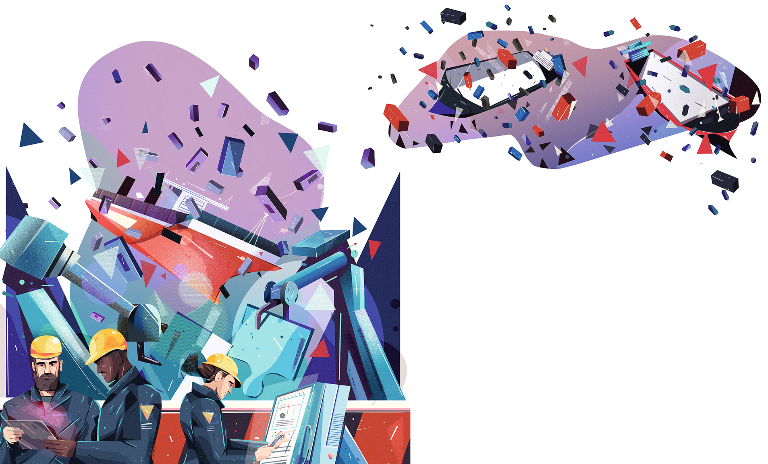How crisis can fast-track business transformation
![{[downloads[language].preview]}](https://www.rolandberger.com/publications/publication_image/TA_32_001_EN_Cover_download_preview.jpg)
Think:Act Magazine explores how successful companies face the challenges of our time with creativity and agility to enter a New World.



Article by Steffan Heuer
Illustrations by Joe Waldron
Read more about the topic "Accelerate and reset"
Globalization as we know it might have run its course as technological changes and corporate strategies lead to more products being made locally or delivered digitally.
Pick a big port, any big port, and behold: More than 32 million shipping containers are in circulation worldwide, enabling an elaborate ballet of components and finished goods circling the globe. The humble, stackable container has become such a symbol for globalization that it has its own monograph simply entitled The Box. If you ordered the newest iPhone, chances were it would leave a factory in China and make its way to your door in just a few days.
And that was the familiar state of affairs until the Covid-19 pandemic suddenly brought global trade to a halt. At least since the 1980s, globalization was the only show in town, its upward trajectory all but inevitable and beneficial to most. China and other parts of Southeast Asia became the world's factory, with China alone contributing more than 28% of global manufacturing output in 2018 – almost twice as much as the US and more than four times the volume of export powerhouse Germany.
Now in 2020, globalization is being fundamentally questioned – and not only due to the novel coronavirus. As the intricately woven global value chains (GVC) have been disrupted or even severed, long-simmering talk of "deglobalization" has gained traction. Companies ranging from clothing manufacturers to car makers are starting to rethink their approach how and where their goods are made.
The aftershocks of the pandemic have the potential to accelerate "nearshoring" as enterprises look to reduce their reliance on a handful of countries and want to shorten their GVC, driven not only by economic considerations, but also technological changes and the rise of populism and protectionism. According to Chinese customs statistics, Chinese exports dropped by 17% during the first two months of the year compared with 2019, while imports fell by 4%. Exports to the EU decreased by almost 30% and to the US by 27%, while imports fell by 19% and 8% respectively. And not only container shipments have tanked. Global hubs like Singapore's Changi Airport saw their passenger count implode from 5.9 million in January to 25,200 in April.
The number of airlines serving the airport fell from 91 to just 35. This dramatic drop may not be mere blip. As of late June 2020, the WTO calculated global merchandise trade shrank by 3% in the first quarter and could fall another 18.5% in the second quarter. Depending on how the pandemic is held in check, world trade could contract between 13% and 32% for the whole year. "Trade may have possibly bottomed out in the second quarter," according to the WTO, with its director-general pointing out that "it could have been much worse."

The optimistic hope for a rebound may be misplaced if one looks at the larger picture painted by the late Cambridge University economist Finbarr Livesey. Globalization as we know it has long gone out of date, but the experts haven't noticed, he argued in his 2017 book From Global to Local. Since his death in 2019, the book has gained new urgency as it lays out the factors that prompted companies to consider nearshoring even before the Covid shock hit. "The accepted interpretation of the future of globalization is misleading and flawed," according to Livesey. "We are running the global economy on a model that went out of date without anyone noticing at some point in the past decade." Globalization, he thinks, has been falsely portrayed as the end of economic history, while the global economy had already started to change its rules.
Different economic phenomena have been lumped together and mislabeled as "globalization," such as the fall in transportation costs, dense communication networks and changes in production technologies. Equally important metrics of globalization, Livesey writes, are foreign direct investments (FDI) and the steadily rising flow of data or bits which all follow their own trajectories. In his view, companies are the key players that have been driving change since 2008, establishing more local production sites that are closer to their respective customers and betting on automation which does not need to incessantly arbitrage wage differences around the world. A robot, after all, costs pretty much the same in Europe, China or the US. "The key," according to Livesey, "is that the geography of production is changing and ownership will matter more as companies will have to be producing in their final market."
Companies and countries therefore need to ask themselves "whether we've become too wedded to one answer to this problem of location and organization, based on an outmoded, out-of-date understanding of technology and organization." In that vein, nearshoring is not an either-or choice that calls for closing overseas plants. Instead, it should be a hybrid model that takes into account the specific market a company wants to serve and how it can keep its supply chain short and reliable.
That is where technology comes in. A tight integration of physical and digital processes enables shorter production in multiple locations and quick customization. Spanish fashion brand Zara, for instance, has long followed a strategy of having its clothes made in places like Portugal, Morocco or Turkey instead of shifting its entire production to Asia. That way, it is able to achieve a shorter cycle time between design and in-store arrival, a crucial advantage in a market as fickle as fashion. The shipping container, introduced in 1956, may have seen its best days. Shipping costs, Livesey pointed out, have not further declined since hitting a low point of about 6% of total costs back in the 1990s. Having components and finished products crisscross the world has another disadvantage besides the longer time to market.
Today, sustainability plays a greater role. "This is not a green agenda or a labor agenda," the late academic concluded, "this is the economic context changing and providing companies with a solution that is more local than global." He believed it is ultimately companies like Zara shaping this new world of production and growing trade rather than politicians from the UK to the US who push protectionist and populist agendas and want to force relocations.
The rethinking of global production is also driven by the rise of automation and new technologies like 3D printing. The startup Desktop Metal, as its name implies, wants to empower companies to print metal parts from a desktop file, replacing automated machining or injection molding. If it works, it could transform where and how car parts or electronics components are manufactured. Combine that with smart factories that are instrumented with loads of sensors and connected to the industrial internet of things, and a company can turn every production line into a data-rich environment where it can gain insights in almostreal time.
The verdict to bid farewell to the old model of globalization is echoed by Anil Gupta, an economist at the University of Maryland and expert on strategy, globalization and entrepreneurship. He takes a different tack than Livesey, though, arguing that old globalization is already being replaced by a new digital globalization. According to Gupta, merchandise trade has been on a glide path to history for a while and globalization in 2020 is defined by technology and digitalization, particularly the rise in services and data transfers. That's why he dismisses the term deglobalization as a "complete mischaracterization" and adds: "To argue that the world is undergoing deglobalization is not all that different from sitting in 2000, looking at the declining sales of chemical films and lamenting the supposed end of photography."
Demand for containers may be going down, but services trade, capital and data flows keep rising. Gupta foresees a new "digital globalization" where economies and enterprises are connected by bits and software and digital services make up a growing part of many products and their ancillary services, from automobiles to smart sneakers.
The innovation inherent in these digitally enhanced products will be the single biggest contributor to economic growth going forward. Foreign direct investments, another motor of globalization, are also on hold, according to the UN Conference on Trade and Development (UNCTAD). It expects businesses to slash FDI by 40% this year and as much as 10% in 2021. Overseas investments will remain subdued through the rest of the current decade. Tellingly, they mention the same factors that Livesey laid out: growing automation, economic nationalism and carbon emissions standards all give companies pause before they sink money into a site half a world away.
Economists have explored the adverse effects of global trade for quite some time and Nobel laureate Paul Krugman, for instance, says that if one looks at labor and income distribution in a rich country such as the US, a more nuanced picture emerges that the profession overlooked. "Soaring imports did impose a significant shock on some US workers, which may have helped cause the globalization backlash," Krugman critiques the academic consensus on trade since the 1990s. "Rapid growth and surging trade imbalances meant that globalization produced far more disruption and cost for some workers than the consensus had envisaged." His prediction dating from 2018 is worth revisiting: "Major disruptions now would be more likely to come from an attempt to reverse globalization than from leaving the current trade regime in place."
Which raises the question: How will countries such as China and India, let alone smaller emerging or outright poor economies, fare under this new globalization paradigm where fewer goods and more data and ideas need to flow freely across borders? Gupta thinks that China has been the biggest beneficiary of merchandise trade growth and thus has the most to lose if the downward trend in overseas manufacturing and nearshoring gains momentum. The ongoing rifts between the US and China over access to key technologies as well as hosting and mining potentially sensitive data will further complicate that country's transition to digital globalization. Trying to position its economy for this new world, India announced a strategy for self-reliance in June 2020. That includes tax incentives and preferential procurement for local products and non-tariff barriers to discourage imports. "All our demands during the crisis were met locally," Prime Minister Narendra Modi said when presenting the plan. "Now, it is time to be vocal about local products and help these local products become global."
As companies work their way through rebuilding or building new, more resilient supply chains and embrace new technologies for smarter production, smaller and weaker economies stand to lose the most. Harvard economist Kenneth Rogoff expects tough times ahead: "There seems little doubt that there are immense political and practical pressures that will prevent globalization from reaching its pre-pandemic level into the foreseeable future. The pandemic gives fuel to anti-immigration and anti-trade forces, which were already on the rise," he says. Rogoff doubts that local production and digital globalization can make up for the losses suffered under the current model. "In some industries, perhaps, in the vast majority, no.
China is the workshop to the world, especially in producing intermediate products. Cutting back trade with China will be a huge negative productivity shock," he adds. If there is indeed a retreat from globalization, the academic says, it will hit developing countries hardest and throw hundreds of millions back into poverty. Small countries, even relatively wealthy ones, he worries, will also suffer. "It is much harder for them to diversify production, and they are quite reliant on being part of global supply chains."
No matter who is right, whether globalization is merely entering a new, digital phase or the world's major powers are retreating from trade as we know it, governments also have their work cut out. While companies are rebalancing and retooling their value chains, politicians need to moderate the impact of the social and technical change that comes with it. Or as Livesey put a positive spin on it, it's an opportunity to address and balance the problems of hyperglobalization.

![{[downloads[language].preview]}](https://www.rolandberger.com/publications/publication_image/TA_32_001_EN_Cover_download_preview.jpg)
Think:Act Magazine explores how successful companies face the challenges of our time with creativity and agility to enter a New World.
